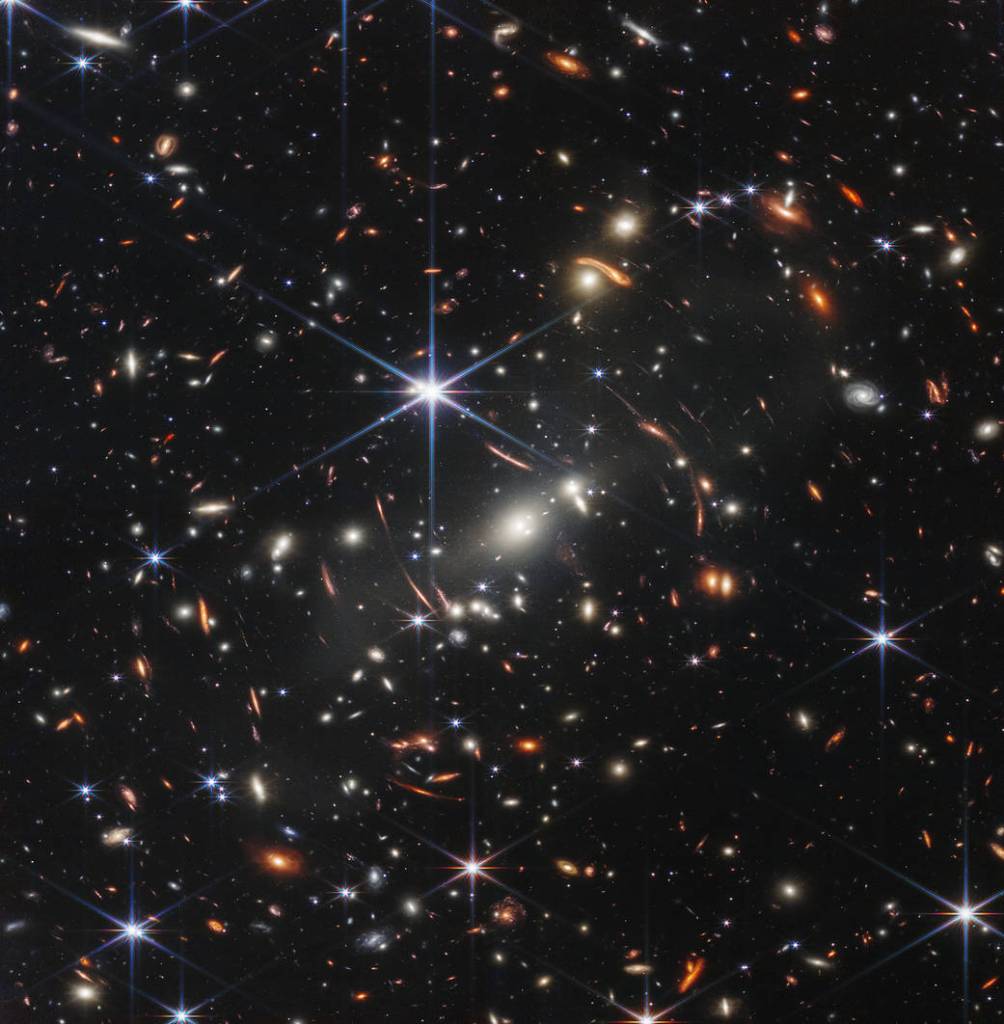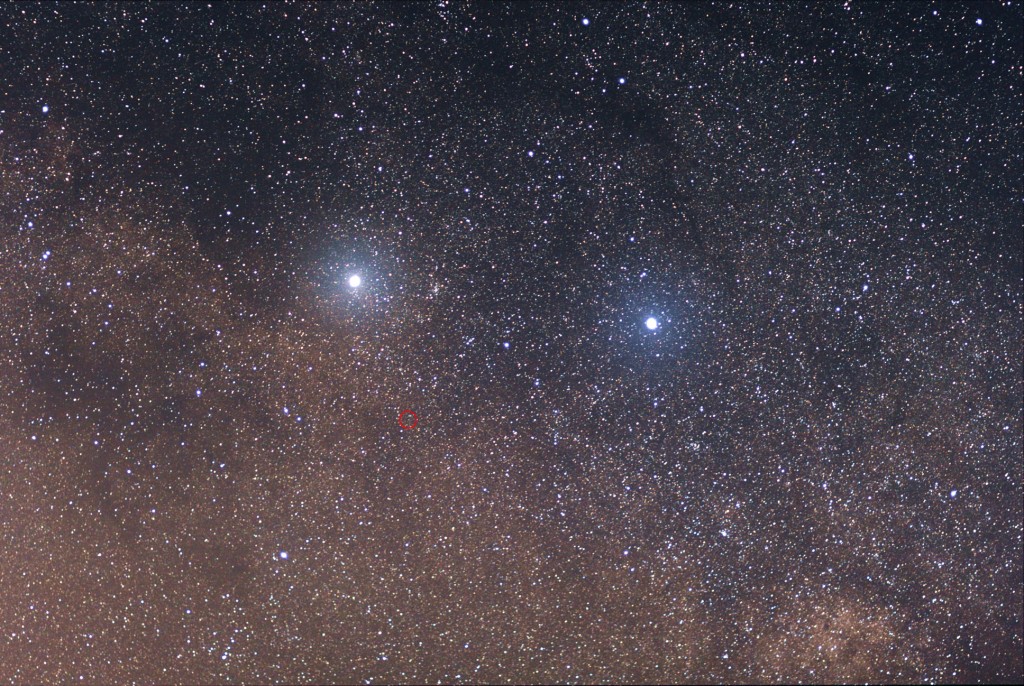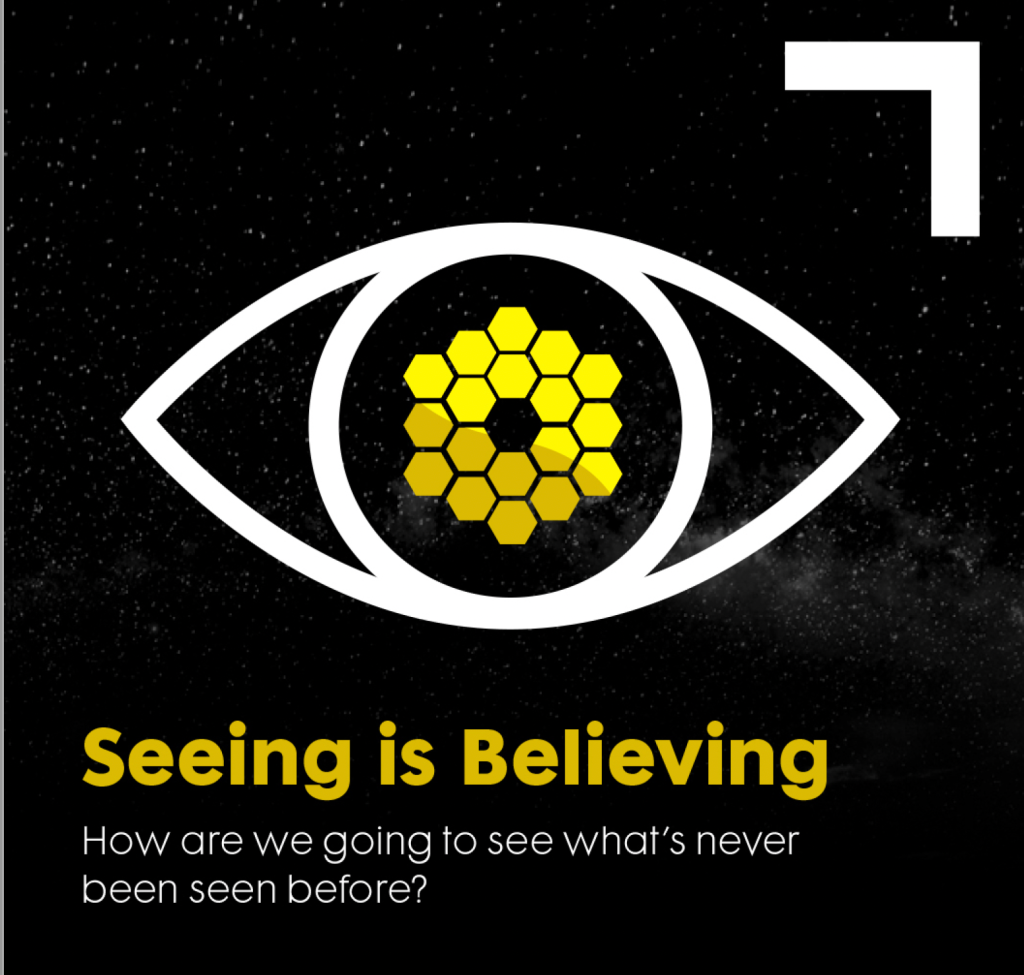After the release of the first deep field images produced by the new James Webb Space Telescope, a Twitter account playfully pretending to be the telescope posted the following:

Cute, of course, and not meant to be taken too seriously, despite the subtle flex of the telescope’s observational powers. But as someone interested in contemporary American religion and the space sciences, this tweet touched on something I’ve been thinking about in anticipation of the JWST’s first images—the omniscient telescope. An eye that can see everywhere and everywhen. What does it mean for a telescope to be showing us the past 13 billion years? What are we looking for out there?
According to NASA, “Webb will be able to see what the universe looked like around a quarter of a billion years (possibly back to 100 million years) after the Big Bang, when the first stars and galaxies started to form.” Of course, that does not mean the telescope can magically produce some kind of record of the known universe for the past forever. What JWST is able to do is see really old light that has shifted into the infrared band as it has traveled in space since the Big Bang. Space and time, being functions of each other, means that being able to see really far in terms of distance also means that you’re able to see really far in terms of time, relative to the observer. So when we look at the deep field image below, some of it is, as the tweet suggests, light from 13 billion years ago, and some of it is not, depending on how far away the light source is. Hubble and other space telescopes can see in infrared, but JWST is newer and better and much more sensitive, thanks to its Near Infrared Camera and its coronagraphs.

Now, the first 100 million years after the Big Bang remains a contentious period. Not everyone agrees on what was happening back then, and that is of some consequence. To get closer, temporally and spatially, to those remnants of the universe’s birth is to court a disenchanted history. If we can master all things by calculation, as Weber famously put it, there can be no more room for gods and spirits (Weber 1917). Right? What can be more disenchanting than cataloging the light from the birth of the universe, than extending the sight of our scientific and analytical apparatus to the furthest reaches of time and space? What are we looking for, out there, if not gods and spirits? Having found no thrones or pure lands, have we finally proved the natural-ness of the heavens?
A few helpful, or necessary, or perhaps just consistent, bulwarks against the tides of disenchantment are the limitations of the human sensorium, our capacity to record and store information, and our contemporaneous experience of the present. If we were to, say, make observations through which we attempt to explain a given phenomena, we could only account for what we could perceive, what we could record and store as statistical data, and what was happening at the time of our observation. This is simplifying a complex problem of ontology (what am I, the observer, and what is the phenomenon, the observed) and semiotics (what does observation mean, how is it interpreted), but the point I’m trying to make is this: we’re limited in what we can observe and what we can interpret, and those limits are the very conditions which make possible things like mystery, surprise, wonder, curiosity, things like that. These limits are what separates us from the gods and their perfect knowledge. The more we deny those limitations and edge towards claims of total objectivity or complete understanding, the more we purge the universe of possibility. What is out there is ultimately not mysterious or unknown, but to-be-known. We’ll get there.
To deny, or obfuscate, these limitation is, to Donna Haraway, to play the God-trick of the sciences (Haraway 1988). Rather than, as Weber said, calculation outright killing the gods, the claim that what calculation and observation does is produce a totalizing and complete knowledge of a phenomenon is the foundation for this sleight-of-hand consecration. Objectivity becomes the language spoken by those who view from nowhere and can see everywhere. For Haraway and others, this easy alliance between naturalistic inquiry and a conquering, colonizing impulse, emblemized by the very notion of objectivity, is the slippery slope to an ill-favored godhood.
But any denial of these limits is always a magic trick, a play of misdirection. Don’t look at our eyeballs, look at our Near Infrared Camera. The anthropocentric impulse to master all things by calculation, inseparable from the rendering of existence into what Heidegger called the “standing-reserve” of resources for that exist only to be used for human ends, may be resisted by foregrounding the limitations described above (Heidegger 1954). As limited beings, humans can only observe and explain so much. If we accept those limits, we leave room for mystery and doubt—for possibilities no one has seen before, to paraphrase President Biden’s remarks at the unveiling of the deep field image. This recognition of our own limitations is 1) necessarily humbling for a hungry hungry humanity, 2) allows for a plurality of different experiences and interpretations and ways of being that reflects more accurately the worlds that people make and live in, and 3) is much better science. We do not need god-emperors in the laboratory; we need modest witnesses (Haraway 1997).
Unfortunately, this all goes to pot once we start using tools. Tools—or, if we want to shift our language somewhat as a gesture towards overcoming the instinct to apprehend the material world as that standing-reserve of matter awaiting human utility, I should say media—like fire and wheels and writing and lenses have always been around, in some form or another, to supplement or augment our sensory capacities, making those very limits I described earlier difficult to pin down, and may perhaps even obscure their existence. Especially in the last few centuries, humans have developed mechanisms for enhancing and expanding the human sensorium that would knock the microbes off van Leeuwenhoek’s slides. Imagine showing Galileo the deep field image. To steal a joke from the Gen Z’ers who live in my phone, it would be like playing a Charli XCX song for a pilgrim.
Media and science studies have been thinking about how to account for tools for ages. Marshall McLuhan wrote that every extension of the human senses a delegation of human ability to the technological form, causing us to misrecognize the conjunction of human and technology as a true reflection of ourselves (McLuhan 1964). One limit, that of our human sensory organs, is surpassed, as the human sensorium has been modulated and reconfigured by the technological augmentations of endless media most beautiful. Friedrich Kittler, another media theorist, explores what it means for us to have developed the capacity to translate sensory information into stored data, a development which consequently carved up the body along sensory lines as hearing solidified into the gramophone, seeing into film, and speech into the typewriter (Kittler 1999). These innovations, translations of the sensory into the material, produced a concept of a past that was accessible through technologies assumed to be of a certain degree of fidelity. These developments expanded our capacity to record and, possibly, went a long way to bringing the past into the present. Karen Barad, quantum physicist and feminist theorist, beautifully argues for a reconsideration of the intra-activity of observer and phenomena, foregrounding the critical indeterminacy of, well, everything (Barad 2006). The observer does not determine the state of phenomena through the mediated processes of observation, the observer and the observed are enacted together. Nothing exists fixed in advance, everything about which we can say anything emerges from the entanglement of human, machine, and phenomena. Our tools do not equip us with the sensory capacity to observe phenomena outside the range of our eyeballs or ears; our tools are an essential part of producing both observers and observed out of a prior indeterminacy. This is confusing, and who knows if I understand Barad correctly, but she still prompts us to think about something crucial that I will return to later—who and what is produced in the act of observing, and whether that production is deterministic.
To recap: science without acknowledging human limits is a charade of mastery and conquest, the God-trick, but those limits become harder and harder to see the better we get at making apparatuses for augmenting our sensorium and storing information. Apparatuses, like the JWST, can tell us a lot about what limitations are being surpassed or obscured and why surpassing those limits might be desirable or advantageous and to whom. Thinking about apparatuses can help us think about what kind of being we become through their utilization, what we see in McLuhan’s reflection, or what we want to see. After all, if we follow Barad, the utilization of an apparatus in the act of observation can modulate both the observed object and the observer in unexpected and indeterminate ways. What do we become by looking out into the deep field through JWST’s eyes?
Right, because this is all about a telescope and limits. A telescope that can see backward in time. That, in and of itself, is not incredibly special. Hubble could see backward in time, too. Any telescope does. Our eyeballs do. When we observe our neighboring system, Alpha Centauri, we’re seeing the light produced by those stars 4.24 years ago. When we look at anything, what we’re seeing is light hitting our retinas, and that light has to be emitted or reflected by an object and travel to our eyes. We might experience this as instantaneous, but it isn’t. Light does not travel faster than 300,000,000 meters per second. That might seem trivial when your eyes are eighteen inches from your cell phone, but it is true. Seeing is always looking backward in time. So what JWST does, better than any other telescope we’ve made so far, is extend the range of human visual sensory capabilities in both space and time and alter the sensitivity of our retina to include light in the infrared.

Alter the sensitivity of our retina to include light in the infrared. That was a very misleading sentence. The JWST does nothing of the kind. The JWST can detect infrared light, which is translated to the human visible spectrum by a broad assemblage of technicians and algorithms, and it then appears on our screens in a manner digestible to our visual senses. Our eyeballs remain the same throughout. But this slippage points towards exactly what McLuhan was getting at—the ways in which the technological augmentation of our senses can cause us to misunderstand or misrecognize the capacities of those very senses and of the human as a whole. Because now, as President Biden said in his address announcing the deep field image, “we can see possibilities no one has seen before. We can go places no one has gone before.” We can do neither, of course. Except we can. We, in President Biden’s language, means humans (Americans), who are now, by Presidential decree, capable of seeing infrared light. The distinction between human and apparatus, the limit the apparatus was designed to surpass, has been successfully obscured. Not only that, but apparently seeing in this way is equivalent to going “places no one has gone before,” to collapsing the distance between ourselves and the objects of our observations, the very origins of the universe itself.
This is why it is very important that we take a moment and think about how we’re going to talk about and understand the JWST and its products. Because, in blasting through the limits of our eyeballs, we may have built a god in our own image. And it only cost ten billion dollars, a bargain. We made something, a gold-plated eyeball floating in the heavens suspended between Earth and Sun, that can leap across improbable distances in space and time. It cannot be everywhere, at all times, all at once, but hey, close enough. So it’s not the Christian god. That’s not the only kind of god out there, after all.
Really, the launch of the telescope is more like the apotheosis of the secular itself. Or of one notion of the secular, the panoptic gaze of modernity. The launch is the creation of a new god of objectivity and total knowledge, a god which offers explanation and observation as understanding and perhaps even ownership. The telescope can claim to see back to the origins of the universe, which it can do, in a fashion. It is entirely wrought by human hands, with human money, designed by human scientists and engineers, yet is more than the sum of its human parts, at least in terms of eyeballs. And like a good telescope god, it can only see and observe. It cannot interfere. It does not violate notions of ultimate human agency or free will. It is a gold eyeball, not an invisible hand. It does not choose what to look at or observe, but rather responds to the transmitted prayers of its earthbound acolytes. It places no limits on us, makes no commands, does not create division between groups any more than any other object produced in partnership with Northrup Grumman.
Importantly, it cannot turn its gaze on its creators. The JWST will never see us. Because the infrared detectors are incredibly sensitive, they must be kept very, very cold—minus 447º F, for the most touchy of its retinas. It has a beautiful silver parasol beneath it which must always be kept in between the infrared eyes and the inner solar system bodies of the Sun, Mercury, Venus, and the Earth. If it is a panopticon, we are not the objects of observation whose subjectivity is produced through the ever-present gaze. That would be the universe. Our prisoner. We’re the guards (Foucault 1975).

That sounds like exactly the kind of god we would make, isn’t it? Distant, observant, hands-off, and capable of bestowing on a hungry hungry humanity immense powers (if you consider being able to see very far a power), and resoundingly American. What was it Durkheim said about religion? Something about the sacred emerging from the social, reflecting the interests and concerns and qualities which had been made authoritatively sacred through collective effervescence (Durkheim 1912)? Instead of using an extant religion to understand the fundamental qualities of a collective social existence, the JWST is an opportunity for us to see that process in action, to see how gods are made. How wrong Weber seems, now. We do not banish the gods by means of calculation. We make the gods we want to have. Be not afraid.

And, most importantly, we make the kind of god that lift us up to the heavens with them. That is the gift of the JWST, after all, the eclipsing and obscuring of human limitations. Alongside it we make ourselves gods, if visuality is next to godliness. We can see possibilities no one has seen before. We can go places no one has gone before. We are not limited inhabitants of the cosmos endowed by our creator with humility and curiosity, we stand astride the cosmos as Rhodes once dreamed of standing from Cape to Cairo, the distance between my iPhone and the Big Bang collapsed by the existence of a single image.

This is not just the ploy of some cabal of scientists who want to conquer the universe, though we can see how the JWST might be the greatest God-trick they’ve ever pulled. That would hardly be “collective” enough to make a god out of an eyeball. If tweets and front-page news coverage are effervescent enough, if the White House briefing room is authoritative enough, if the deep field image suddenly appearing as wallpapers and screensavers and cover photos the world over is collective enough, well, I think I’ve made my point. If the sacred is a reflection of ourselves, what we see in that reflection is not a human that can build a telescope, but a human that can see in infrared.
Back to Barad, in closing. Indeterminacy. Enactment. When JWST opened its eyeballs, that was the first step in enacting the cosmos, not determining it. Or, and perhaps this is just how I’m understanding Barad, the opening of those eyeballs produced a new kind of relationship between observer, apparatus, and phenomenon, the enactment of which produces each element in kind. So, on the one hand, we have a relationship in which the powers of the observer are such that the apparatus is both obscured and elevated and the universe appears as a passive object of our observational capacities. It is something to look at. A place to go. The universe as rendered in the deep field image exists out there as a resource, not like fossil fuels or gold (though you need both to see the universe) but as the stuff which makes it possible for us to revel in our new infrared-seeing eyes. It is a resource more akin to classical music or a Monét, that which conjures in us a sense of wonder and awe at human potential. To Barad’s quantum physics point, the universe might as well not even exist until we observe it, capture it, and feed it into our cultural god-factory.
But the indeterminacy of the phenomenon is only half of Barad’s point. The apparatus produces the observer and the phenomenon in relation to one another. Neither exists in advance, everything is constantly being produced and reproduced, us included. And we can actually see that at work already in this god-eyeball scheme, how the character and composition of the observer, the human that can see in infrared, emerges from the observation of the deep field. But I guess that is not really true, is it? That is a notion of the human that is justified by the deep field image, but that notion preceded the opening of the golden eyeball. By that I mean, why would we build a telescope that could see in infrared if we did not already think there were things worth seeing out in space in the infrared band? Why would we launch our golden eyeball if not to see all of the history of the universe all at once? Before the JWST unfolded into its deployed form at the Lagrange point it now calls home, the deep field image existed as a dream, a hypothesis, an expectation, a resource, the self-fulfilling prophecy of the human that can see in infrared.
Is there any other way to understand the deep field images? When we ask what we were looking for out at the edges of the universe, is there an answer that does not orbit a clichéd “ourselves”? The god is out of the proverbial bag now, and we have to live with these images. Can we see them as anything other than the evidence that we’ve become humans that can see in infrared? Perhaps only if we can remember that observation changes the observer in indeterminate ways, just as the act of observation produces the phenomena under investigation. When we look at the deep field image, instead of asking ourselves what we are looking at, perhaps we should ask how is it that we are able to look, or what kind of observer do we become through the act of looking. Are we awed by ourselves and what we can do, the possibilities we’ve produced and the places we can go, or can we see the lights in the deep field as a collection of pale blue dots, only a small sliver of the mysteries and vastness of the universe (Sagan 1994). Not a picture of the universe from 13 billion years ago, not an ocular God-trick, but the abyss staring back at us, reminding us that, if a similar image was taken from the perspective of that ancient light, we probably would not be visible.
I do not want to just argue that smallness is next to goodliness, though it might be. We may not be able to make ourselves small again, now that we can see the beginning of time. What can a return to considering our limits do now that they’ve disappeared? I want to encourage us to sit with the deep field image and think about the act of looking, the enactment of this relationship, and what kind of observer we are becoming. We do not have to become the human that can see in infrared. We need not authorize the JWST as the sacred secular. I can’t know what kind of observer we’re becoming, have already become, but I can end with one more misleading sentence. We have to think about what it means for us to see the beginning of the universe.
“There is no such exterior position where the contemplation of this possibility makes any sense. We are of the universe—there is no inside, no outside. There is only intra-acting from within and as part of the world in its becoming” (Barad 2006, 396)
Works Cited
Barad, Karen Michelle. Meeting the Universe Halfway: Quantum Physics and the Entanglement of Matter and Meaning. Durham: Duke University Press, 2007.
Durkheim, Emile, and Karen E. Fields. The Elementary Forms of Religious Life. New York: Free Press, 1995.
Foucault, Michel. Discipline and Punish: The Birth of the Prison. 2nd Vintage Books ed. New York: Vintage Books, 1995.
Haraway, Donna. “Situated Knowledges: The Science Question in Feminism and the Privilege of Partial Perspective.” Feminist Studies 14, no. 3 (1988).
Haraway, Donna Jeanne. Modest_Witness@Second_Millennium. FemaleMan_Meets_OncoMouse: Feminism and Technoscience. New York, NY: Routledge, Taylor & Francis Group, 2018.
Heidegger, Martin, and William Lovitt. The Question Concerning Technology, and Other Essays. 1977.
Kittler, Friedrich A. Gramophone, Film, Typewriter. Writing Science. Stanford, CA: Stanford University Press, 1999.
McLuhan, Marshall, and W. Terrence Gordon. Understanding Media: The Extensions of Man. Critical ed. Corte Madera, CA: Gingko Press, 2003.
Sagan, Carl. Pale Blue Dot: A Vision of the Human Future in Space. New York: Ballantine Books, 1997.
Weber, Max. “Science as Vocation.” In Science, Reason, Modernity: Readings for an Anthropology of the Contemporary. New York: Fordham University Press, 2015.




